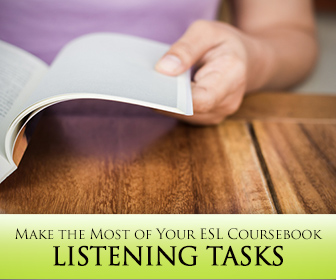ESL Coursebook Listening Tasks: 6 Steps to Make the Most of Them


It not only prevents injury, it also gets athletes’ bodies prepared for the strenuous activity to come. Although chances of injury are slim to none when it comes to listening exercises, it is still very important to allow the class to warm up. A listening activity can be quite strenuous for some students, and a good warm up will make the listening task less confusing and more effective. Here are some terrific warm-up exercises to help your students prepare their ears and stretch those listening muscles.

One of the obstacles we encounter in listening activities is getting students interested in what they have to listen to. If there is no real interest, chances are they won’t really listen. One of the ways of generating this interest is by introducing the topic in a way that is engaging and effective. You can have them read the first few lines of a conversation, predict what will happen next, and then listen to the rest. Or you could have students read some background info about a product, company or person, before the actual listening task.
Another great way to get students warmed up for a listening task is to test their previous knowledge about the topic that will be covered in the listening. For example, if the audio is two people talking about adventure sports like whitewater rafting, caving or mountain climbing, ask students if they have ever tried any of these sports. Which ones would they like to try and why?
This is a great way to get students to anticipate a topic, issue or situation. Reveal some of the facts/information that is presented in the first 30-60 seconds of the audio. For instance, say: A man tells a friend he has just returned from his vacation. What questions do you think his friend might ask? Students may then brainstorm a series of questions that you can write down on the board. After the listening, students compare their questions to what was actually asked.
Ask students to read the title of the chapter, section or exercise. For example, say the title is “Putting Your Best Foot Forward”. Ask your class: what does it mean to “put your best foot forward”? Have them supply some examples of what that would be. In which situations is it important to “put your best foot forward”? This warm up is perfect for titles that include phrasal verbs or expressions that students are not familiar with. This not only prepares them for what the listening will be about, it also teaches them new vocabulary.
Before running or doing exercise, we have to stretch our muscles. Have students stretch their listening muscle by listening to one or several short audio cues. If they will have to listen to a conversation that takes place in a restaurant, play a short audio track of restaurant background noise – no talking, just the “noise” – and have them guess the place. You can also play city noises like an ambulance or police car, birds chirping, ocean waves, or any type of noise. By playing the background noise that corresponds to the scene, you are placing your students in that scene, and thus effectively preparing them for the conversation that will follow.
The picture warm up is ideal for visual learners. Simply show them a picture that relates to the topic or situation covered in the listening. Again, say they’ll hear a conversation taking place at a restaurant. Show them a picture of two people eating at a restaurant. Have them describe the scene to you: where are they? What are they doing at the restaurant? What are they talking about? What is the relationship between them?
Let’s suppose your class will be listening to someone describing how a particular holiday is celebrated in their country. Say it’s a holiday like Christmas; ask your class to write down five words or ideas that they associate with this holiday. A student’s list may look like this: family, turkey, presents, singing, celebrating. Students share their individual lists and then listen to see if any of the things they wrote down are mentioned.
You can probably tell these warm ups have one basic thing is common: they all introduce the topic to the class. Why is this important for better ESL listening? Well, it should be evident by now, but the most effective listening is the kind that sets up the context first. It gives your students a foundation from which to tackle the audio material. If you don’t give them context, they will have to figure it out as they listen. If you help them figure it out beforehand, they will have less “figuring out” to do and will be able to focus on other tasks like listening for details or answering questions.
They will have fewer listening “accidents” and more of a listening “workout”.